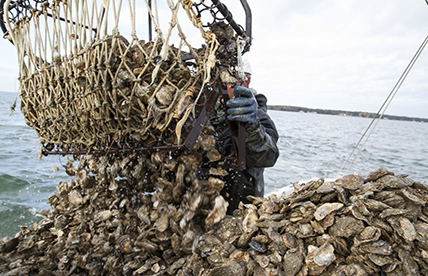ANNAPOLIS — The number of oystermen cited or given warnings for having undersized oysters was at a five-year low this season, which some Maryland Department of Natural Resources officials said is the result of a particularly strong harvest.
There were so many full-size oysters in the Chesapeake Bay this year because 2010 was an exceptional reproductive year and there has been low disease mortality since then, said Michael Naylor, the shellfish program director at the Department of Natural Resources.
“Now they’re reaching market size in great numbers,” he said.
When the oyster population is high, fewer oystermen feel the need to catch them when they’re still undersized, said Candy Thomson, Maryland Natural Resources Police spokeswoman.
Naylor said the 2012-2013 harvest was about 340,000 oyster bushels and while this season’s numbers have not been fully tallied, he expects the number to be significantly higher. Maryland oyster season runs from Oct. 1 to March 31.
He said that the harvest in 2004 brought only 26,000 bushels of oysters across the bay.

Maryland’s Natural Resources Police considers any oyster under three inches to be undersized, and allows five percent of the oysters in a bushel to be undersized as a leeway to oystermen.
“If you’re really paying attention to what you’re doing, you might have one or two (undersized oysters),” said Jim Mullin, executive director of the Maryland Oyster Association.
During the 2013-14 harvest season, 30 citations were given out for possession of undersized oysters, according to data from the Maryland Natural Resources Police.
This was half the 60 citations given out during the 2011-12 season. There were 34 of the same citation during the 2012-13 season.
The Natural Resources Police also gave out nine warnings this season, according to the data.
Naylor said poaching undersized oysters is dangerous to the ecosystem because they do not begin reproducing until they are about three inches.
“It’s a direct threat to the reproductivity capacity of the whole fishery,” he said.
While undersized oyster possession is one of the most common recorded violations, Mullin said the problem is not very widespread.
“It’s the same select few (oystermen), but it reflects badly on the entire industry,” he said.
Thomson said law enforcement officials use a tool with a three-inch opening to determine whether an oyster is below the legal size.
In January, police stopped a tractor-trailer in Easton on Route 50 which had 187 undersized bushels out of the 188 it was carrying.
“I was there and I can tell you they measured every oyster,” Thomson said.
While this year’s harvest was strong and violations were relatively low, similar ecological conditions are needed to allow for another abundant oyster reproductive cycle in the future.
During a strong reproductive season, the oyster larvae need to be in the right development stage, there has to be good water quality and there needs to be a clean place for attachment, like a shell, said Don Meritt, director of the University of Maryland Center for Environmental Science’s Horn Point Hatchery.

Naylor said that he does not believe the next oyster season will be significantly bigger than this year’s, but anticipates this year’s high numbers to be maintained next season.
This year’s numbers remained high despite icy conditions. Last month, state officials denied requests to extend the season to make up for days lost because of the weather.


You must be logged in to post a comment.